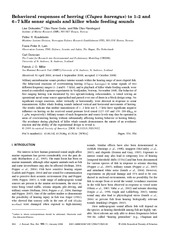Behavioral responses of herring (Clupea harengus) to 1–2 and 6–7 kHz sonar signals and killer whale feeding sounds
Doksæter, Lise; Godø, Olav Rune; Handegard, Nils Olav; Kvadsheim, Petter H.; Lam, Frans-Peter A.; Donovan, Carl; Miller, Patrick J. O.
Peer reviewed, Journal article
Published version
Permanent lenke
http://hdl.handle.net/1956/4732Utgivelsesdato
2009Metadata
Vis full innførselSamlinger
Originalversjon
https://doi.org/10.1121/1.3021301Sammendrag
Military antisubmarine sonars produce intense sounds within the hearing range of most clupeid fish. The behavioral reactions of overwintering herring Clupea harengus to sonar signals of two different frequency ranges 1–2 and 6–7 kHz , and to playback of killer whale feeding sounds, were tested in controlled exposure experiments in Vestfjorden, Norway, November 2006. The behavior of free ranging herring was monitored by two upward-looking echosounders. A vessel towing an operational naval sonar source approached and passed over one of them in a block design setup. No significant escape reactions, either vertically or horizontally, were detected in response to sonar transmissions. Killer whale feeding sounds induced vertical and horizontal movements of herring. The results indicate that neither transmission of 1–2 kHz nor 6–7 kHz have significant negative influence on herring on the received sound pressure level tested 127–197 and 139–209 dBrms re 1 Pa, respectively . Military sonars of such frequencies and source levels may thus be operated in areas of overwintering herring without substantially affecting herring behavior or herring fishery. The avoidance during playback of killer whale sounds demonstrates the nature of an avoidance reaction and the ability of the experimental design to reveal it.
Utgiver
Acoustical Society of AmericaOpphavsrett
Acoustical Society of AmericaCopyright 2009 Acoustical Society of America
